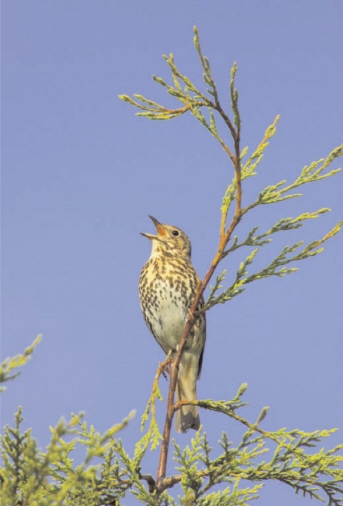
As well as flying, breeding and feeding, there is a range of behaviour that birds undertake during their daily lives. This chapter features images showing some of the other things birds get up to that – although they may be related – are not directly linked to the above activities.
All the birds in these pictures are engaged in some sort of activity, in contrast to the inactivity that typifies bird portraits. Some of them fall into what is known as ‘action’ photography, although there is no strict definition of this. All behaviour tends to be ‘action’ of some sort or other, but usually ‘action photography’ is where there is a lot of dynamism in the picture, caused either by the vigorous actions of the bird itself (e.g. a bird washing with water flying everywhere), or by interaction between more than one bird (e.g. two birds fighting).
For the sedentary among us, the term ‘action photography’ may seem a little daunting, perhaps conjuring up images of the photographer rushing around being very adventurous and proactive. This may work in some situations, but I generally find that the two most important elements for photographing birds in action are location and patience. Once you have found a location where there are lots of birds around, get yourself set up and simply wait and wait, then, when you get fed up, wait some more. The most important thing is to remain alert while waiting around for something to happen. When the action starts it is often over in a few seconds, and if you are not ready you will miss it.
Other action pictures are totally opportunistic and can occur anywhere at any time. Whether you take advantage of the situation when it arises is down to you. You can improve your chances by knowing your subject well, which enables you to anticipate when it is going to do something. The other factors are constant alertness and quick reactions to capture the moment. Above all, this type of photography is great fun and can result in great images.
SINGING
For a vast group of small birds, singing is one of the most significant forms of behaviour in their lives – which is why they’re known as songbirds. It’s not the most spectacular type of behaviour to photograph, I grant you, but this is what they do, so this is what you photograph. Photographing a small, perched bird singing is often the best you can do as far as behaviour is concerned, but it does add considerable impact over a similar portrait-type shot, where the bird’s mouth would be closed and its posture less engaging. Male birds sing to establish a territory in the spring and to ward off any potential rivals for a prime spot, but singing is not restricted to this time and can occur at almost any time of the year.

 SONG THRUSH
SONG THRUSH
(Turdus philomelos)
Canon EOS 1D Mark II, 500mm f4 lens + 2x converter, tripod, 1/800th sec @ f9, digital ISO 400
Essex, UK
The shot opposite was actually taken in my back garden deep in the wilds of Essex. It was a lovely, sunny spring morning and I was carrying out some much-needed garden maintenance. This male Song Thrush landed in the top of a large Leylandii conifer on the boundary of my property and started singing his heart out. ‘Song Thrush’ is a very apt name, and you can’t believe how much noise such a relatively small bird can produce. The infamous Leylandii is very fast growing, shooting up to more than 20 metres in height, blocking people’s light and causing many disputes between neighbours. I thought this would be a good opportunity to show wildlife together with the newsworthy tree, and disappeared indoors to get my camera gear.
When I returned the bird had moved to a new perch, this time right at the very top of the tree. The tip curved up and arched over the bird, making a really nice composition. The trouble was that it was very high indeed, and I needed to add a 2x converter to my 500mm lens in order to get a reasonable image size. Because I was using the 2x converter I stopped down just a fraction from f8 to f9. I did this because I find that even this small change in aperture will considerably reduce the inevitable slight vignetting that you get when using the converter, a flaw that would be noticeable against a clear blue sky such as the one in this picture.
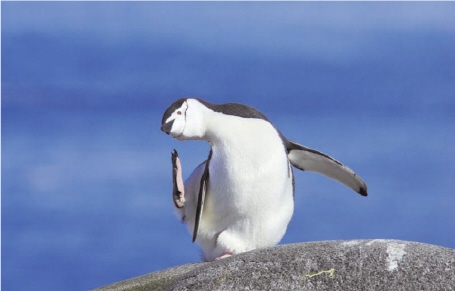
 CHINSTRAP PENGUIN
CHINSTRAP PENGUIN
(Pygoscelis antarctica)
Canon EOS 1D Mark II, 400mm f4 lens + 1.4x converter, hand-held, 1/1,250 sec @ f10, digital ISO 400
Antarctica
PREENING
A bird’s feathers fulfil a variety of functions, including keeping it warm, waterproof and attractive to the opposite sex, so keeping its plumage in good order is very important in its daily routine. Of course, apart from this regular maintenance, there will always be that sudden urgent itch to scratch as well. With no hands to rely on, all this work has to be undertaken by using the bill if the area concerned is within reach. If not that it will have to be the claws, although it may require a considerable amount of effort, not to say balance, to reach exactly the right spot.
I was visiting Half Moon Island on the Antarctic peninsula, and had come across a large colony of Chinstrap Penguins. I was sitting fairly close to the colony, trying to visualize a picture. This was not easy because the colony was quite large and a confusion of birds was spread out before me. I just couldn’t get a shot without a jumble of bits of other birds in the background, and I was looking for a much cleaner, graphic shot. It was then that I noticed a large boulder to one side of the colony with a lone penguin sitting on top of it. I couldn’t get any closer to the rock as the penguin colony was in between us, but after a lot of shuffling around, I did manage to find myself a position where I could use the sea as a background and exclude the tops of the other penguins that surrounded the rock. It was then that the bird stretched its head to one side and lifted its foot to scratch itself, and I took the picture shown.
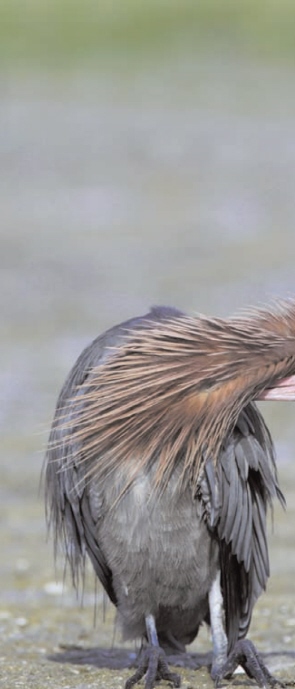
 REDDISH EGRET
REDDISH EGRET
(Egretta rufescens)
Canon EOS 1D Mark II, 500mm lens + 1.4x converter, tripod, 1/640th sec @ f9, digital ISO 200
Florida, USA
The clean background really makes the picture work – you wouldn’t believe the mess just out of frame. When arriving at a bird colony it is very easy to quickly take lots of bad pictures, but I find the best approach is to sit and look until you find a scene that will work. The other aspect to this image is humour, as the rather awkward position that the bird is in does look comical – and anything that brings a smile can be no bad thing.
Some species of bird, like the herons and some waders, have very long bills, which they use to great effect when preening, as can clearly be seen in the case of the Reddish Egret on the left. Unlike the same species depicted, this bird is the normal form. It is the colour of the rather shaggy looking neck that gives the bird its name. (‘Brownish’ Egret might have been more accurate, but considerably less attractive.)
The picture was taken at Estero Lagoon in Florida. The lagoon is a long stretch of water just a few metres from the sea, from which it is separated by a sandy beach. The whole area is known as Fort Myers beach and is a popular tourist spot. Just 50 metres behind the bird, the land is completely covered by high-rise hotels packed with holidaymakers. The lagoon is very shallow, and many waders and terns come here to rest up at high tide. I’d found a slightly raised area of mud that had attracted some birds and set up to take some pictures, when this Reddish Egret flew in. The Reddish Egret is far more coastal than the other Florida members of the heron family, so I wasn’t surprised to see one here. However, what it did when it sat down and started preening did surprise me. Something looked odd, but I couldn’t work out what it was. Then it dawned on me – the egret was sitting with its legs folded frontwards at the ankle, but of course a bird’s ankles are positioned halfway up the visible part of its legs, so we tend to think of a bird’s ankles as its knees. Seeing the legs bent ‘the wrong way’ like this is peculiar to our eyes – I was certainly quite happy to photograph it.
BATHING
Photographs of birds bathing are pretty easy to take, but the behaviour can produce some lovely images. I always think that splashing water really adds impact to a picture, and the more water flying about the better. The water droplets caught in mid-air and the churning of the water around the bird’s body just say ‘action’. It is, of course, possible to photograph any species of bird having a refreshing bath, but the bigger the bird the more water is likely to be displaced – and they don’t come much bigger than the common old Mute Swan shown on the right. It just goes to show that you can produce interesting images of the most familiar of species if you keep your eyes open.
I was wandering around the Wildfowl and Wetlands Trust reserve of Slimbridge on a rare sunny day in the middle of winter. The birds are fed in the afternoon and after all the food has been consumed, many of the wildfowl start to bathe. There was a large number of Mute Swans and many of these started to bathe at the same time. Mute Swans are powerful birds and they splash around very vigorously, water flying everywhere. The biggest problem from a photography point of view was that there were so many of them in a small pond that they would constantly be in each other’s way. For the shot below, I had to carefully select my subject and shoot from as high an angle as possible to exclude the other swans behind it, cropping closely to the bird. Having to underexpose by a stop to make sure the white of the bird didn’t blow out has left the water a darker blue than it really was, but the contrast with the white bird adds to the drama of the picture and shows those all-important water droplets very well. The open bill of the swan adds more impact to the image and gives the impression that it is really enjoying itself.
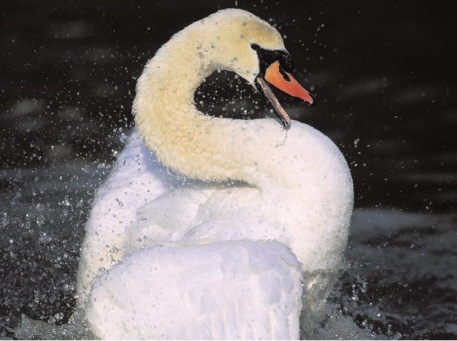
 MUTE SWAN
MUTE SWAN
(Cygnus olor)
Canon EOS 1V, 300mm f2.8 lens + 1.4x converter, hand-held, 1/2,000th sec @ f4, Fuji Provia 100
Gloucestershire, UK
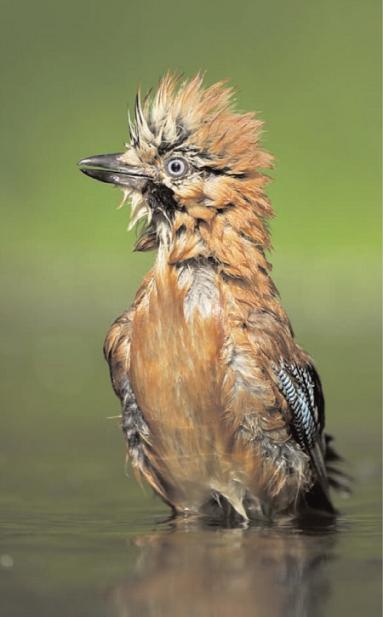
 JAY
JAY
(Garrulus glandarius)
Canon EOS 1Ds Mark II, 500mm f4 lens, tripod, 1/640th sec @ f5, digital ISO 400
Hungary
When birds bathe they do so in bursts. Vigorous splashing about with their wings is frequently followed by a pause as they rest themselves before another burst of activity. They may do this simply to rest their tired muscles, or it could be that they feel quite vulnerable while washing, and frequently stop to take stock of their surroundings, checking for the presence of any predators before continuing.
Either way, the image of a Jay on the left, caught in this moment of inaction, is in sharp contrast to the picture of the swan on the preceding page. It shows no movement and certainly no splashing water, so it lacks the action of the previous picture. Clearly, however, the bird has been bathing, as can be seen by the state of its feathers.
I’d been photographing the Jay washing merrily away in a woodland pool in Hungary for some time, when it suddenly stopped. I had expected it to fly away now that it had finished, but instead it stood there in the water for some time. I just loved the way the water had made the feathers stand up around the head, giving the bird a rather startled look, which was enhanced by the large, seemingly staring eye and the slightly open bill. The result is a rather clown-like view of this species, which demonstrates quite well that you can make good behaviour pictures even when little is actually happening at the time.
RUNNING
Most birds don’t actually run around very much at all, preferring far more energy-efficient walking instead. This is not a behaviour that you can easily set out to photograph, but one that you may happen upon while out with your camera. The secret to success with this type of image is to pan smoothly, keeping the bird in the same position in the viewfinder as it runs along. In this respect the technique is not dissimilar to flight photography, but with one big advantage: the target bird can only move backwards or forwards, whereas a flying bird can disappear from your viewfinder in any direction.
The picture on the right was taken while I was in the Shetland Isles and had come across a group of Sanderlings in breeding plumage on a remote beach. I didn’t have a hide with me and the shoreline was too far away to be able to shoot from the car, so I sat down on the beach with my camera on the tripod and waited for the Sanderlings to wander. After a while they pretty much ignored me, and I got some pictures that I was quite pleased with. It was then that I noticed a Ringed Plover walking along the beach. Unlike the Sanderlings, the Ringed Plover was breeding in the immediate area. It walked quite speedily along the very edge of the shore and would occasionally dash about very quickly, seemingly in no particular direction. As it worked his way along the beach towards me, I focused on it and followed it in my viewfinder. When it started to run I was already on it, so all I had to do was to press the shutter. As I looked through the viewfinder I noticed dozens of those flies that you find on seaweed-strewn beaches. What I couldn’t work out was whether the bird was chasing the flies in order to catch them, or if it had simply disturbed them as it ran along the shore (I never saw the bird catch one).
The flies add interest to the picture, but there are other factors that make it work. The first is the positioning of the bird moving into the frame. The second is the back leg, which is raised off the ground giving the impression of speed in a still picture, an effect that is increased by the sand that is being kicked up by the running bird. The positioning of the bird is something we have control over, the foot and sand is something we don’t, but a good image is often a combination of both skill and luck.
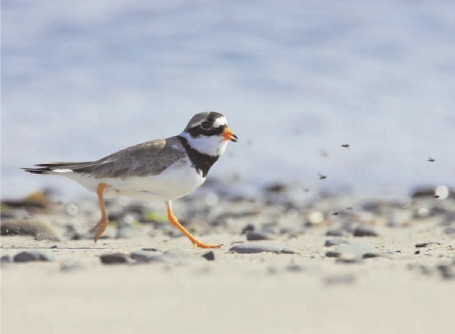
 RINGED PLOVER
RINGED PLOVER
(Charadrius hiaticula)
Canon EOS 1D Mark II, 500mm f4 lens + 1.4x converter, tripod, 1/1,250th sec @ f8, digital ISO 400
Shetland Isles, UK

 COMMON GUILLEMOT
COMMON GUILLEMOT
(Uria aalge)
Canon EOS 1Ds Mark II, 400mm f4 lens + 1.4x converter, hand-held, 1/500th sec @ f5.6, digital ISO 400
Norway
Waterbirds probably run more frequently than do land birds, and are often easier to photograph. Many run in order to reach sufficient speed to take off, but some, like the Common Guillemot (above), run over the water to move from one place to another without getting airborne. This is because for these short-winged birds, running uses up less energy than flying. In pictures featuring running over water, like in the bathing pictures discussed earlier, splashing water becomes a major component of the image, adding dynamism to the composition.
One of the best ways to photograph seabirds running over the water is from a boat near a breeding colony. I was off the northern coast of Norway in late winter, bobbing about in a very small boat indeed. We were just off some seabird islands that provided some shelter from the howling winds, although the sea was still rough and it was difficult to stand upright in the boat, let alone take pictures. Given the time of year, I was surprised to find so many seabirds close to the breeding islands – there were hundreds of guillemots in large rafts on the sea’s surface. As the boatman manoeuvred us closer, many birds ran out of our way, giving us the opportunity for shots like this.
It was an incredibly dull, overcast day, and with the boat lurching violently from side to side and the birds running quickly over the sea, this was not an easy shot to take and I could only shoot at 1/500th of a second. Panning with the bird certainly helped to make the most of the speed I had, and I was pleasantly surprised to find a number of sharp images among many that were not. The resulting picture is full of action, although I would have preferred the line of splashes in the top right-hand quarter of the frame not to have been there. These were left by another bird, running out of frame. Despite this I think the picture is strong enough to still be successful.
FLOCKING
So far the images in this chapter have concentrated on the behaviour of a single bird, but some of the most spectacular scenes in nature occur when large numbers of birds join together to form flocks. One of the most striking gatherings can be found around the shores of the United Kingdom at high tide, as wading birds forced off their feeding grounds out on the mudflats come together to rest and wait for the tide to recede so they can continue feeding. The Knot forms the most spectacular, densely packed flocks as the birds huddle down together and catch some much-needed sleep. These gatherings only happen outside the breeding season, and at this time the birds are in dull grey winter plumage, so are not in themselves particularly photogenic. When photographed en masse at a high tide roost, though, the result is an amazing demonstration of the wonders of the natural world.

 KNOTS
KNOTS
(Calidris canutus)
Canon EOS 1V, 600mm lens + 2x converter, tripod, approx. 1/250th sec @ f8, Fuji Provia 100
Norfolk, UK
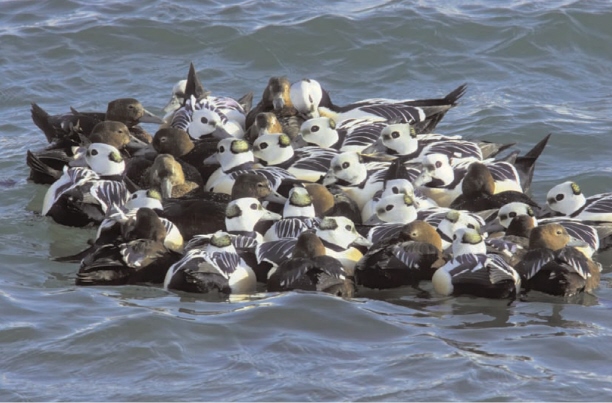
 STELLER’S EIDERS
STELLER’S EIDERS
(Polysticta stelleri)
Canon EOS 1D Mark II, 400mm f4 lens + 1.4x converter, beanbag, 1/500th sec @ f16, digital ISO 400
Norway
High tide was very early on this particular morning, and as I made my way to the public hide at Snettisham RSPB reserve in Norfolk in the middle of winter, it was still rather dark. The birds roost in a large gravel pit just a short flight from the mudflats of the Wash, and the hide I had chosen was directly opposite the bank of gravel that formed the side of the pit. I had been to Snettisham many times before, so I knew that this was where the Knots roosted. Photographing thousands of birds roosting together is nigh on impossible on the flat, but at this spot I knew they would form a ‘wall’ of birds up the steep gravel bank, which would make a much more interesting image.
Because of the width of the gravel pit the hide I was in was still some distance away, so I needed my 600mm lens plus a 2x converter. Due to the dull conditions (I was still using film at the time), keeping this huge set-up still was essential to avoid camera shake, since I could only manage 1/250th of a second at maximum aperture. Because of this I took several rolls of film to make sure I got the shot I was after.
The flocking of Steller’s Eiders has one thing in common with the roosting Knots on the previous page – it only occurs outside the breeding season. With some exceptions, birds do tend to flock at this time, when they are far less territorial and seek out others of the same species for safety in numbers. I photograph a lot of wildfowl because they are favourites of mine, but I have never seen any of them behave like the Steller’s Eiders above. Many ducks form small rafts of birds in winter, but never as squeezed up as these delightful little birds, which were so closely packed that it was more like watching a single organism than 35 – yes, I know it’s a bit sad, but I actually counted the number of birds in this picture. Most of them are the very colourful males, but there are several of the dark brown females in the image as well. Quite why they form these closely packed rafts I have no idea, but they do it all the time – and when I saw this behaviour I just had to photograph it.
Steller’s Eider is one of three eider duck species that winter in north Norway, the others being King and Common Eiders. The weather was very rough on the open sea due to the gale-force winds, and a large flock of these birds had taken shelter in the harbour. This was good news because they were far more easy to photograph here than they would have been out at sea; what’s more, this could be undertaken from the relative shelter of our vehicle. We had hardly seen the sun for the whole week, but it popped out of the clouds, scudding across the sky for just a few minutes. It was at this moment that I took this picture. As in the case of the picture of the Knots, it was difficult to photograph the flat raft of eiders – the majority of the birds were hidden behind those in the foreground and didn’t show the raft very well. There was, however, quite a swell on the water. I watched carefully and waited for the precise moment when the swell passed under the front birds and lifted the back birds up in the air. This gave me the result I was after, as all the birds in the little raft were now visible.
The sun really helped – I was able to stop right down to f16 and still shoot at 1/500th of a second due to the bright conditions, and to allow for the white on the males’ heads. I needed as much depth of field as possible to render all of the birds in the raft sharp, because I was shooting with a long telephoto lens.
FIGHTING
In some ways a photograph of birds fighting is the ultimate ‘action’ shot. It is something I am always on the lookout for, although it is often difficult to predict. Birds fight for a number of reasons: over food, to defend or acquire a territory, or to see off a rival for their breeding partner. Although I have seen females fighting occasionally, it’s normally the males that indulge in this practice. To anyone who has been to a disco on a Saturday night, this will come as no surprise.
When I took the shot below I was just off the rocky shore of South Georgia in the South Atlantic Ocean, and it was a miserable day – not unusual in the Antarctic region.
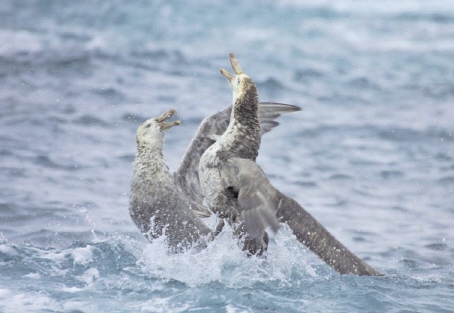
 NORTHERN GIANT PETRELS
NORTHERN GIANT PETRELS
(Macronectes halli)
Canon EOS 1D, 100–400mm lens @ 310mm, hand-held, 1/400th sec @ f5.6, digital ISO 400
South Georgia

 OSPREYS
OSPREYS
(Pandion haliaetus)
Canon EOS 1D Mark II, 500mm lens + 1.4x converter, tripod, 1/1,000th sec @ f8, digital ISO 200
Florida, USA
There was a steady drizzle and the sea was too rough to land on the shore, so we set off in zodiacs and cruised around the rocky shoreline to see what we could find to photograph. I decided that a telephoto zoom would be light and easy to shoot with on a crowded, rolling little rubber boat. A male Northern Giant Petrel raised himself up in a threat posture as another came towards him, but at this moment the zodiac spun around in the current. I quickly gathered my bearings and got on the two birds as they leapt out of the water in an extremely brief encounter.
As mentioned, fighting can break out at any time for a variety of reasons, and this was certainly the case when it came to the above picture of two Ospreys fighting over a nest site. Although Ospreys are birds of prey, I have never thought of them as particularly aggressive, and had never seen them fighting before I took this shot on a two-month trip to the state of Florida. However, disputes over nest sites and mates are not that unusual in spring.
We were visiting Cypress Lake in the centre of Florida and away from the main birding areas close to the coast. The lake was surrounded with cypress trees, which made viewing difficult, and access was very restricted unless you had a boat – which I didn’t. My wife and I searched around the edge of the lake by a boat ramp and finally found a spot that gave me a shot through the trees towards an Osprey on its nest. It was a very narrow angle, as tree branches obscured the view on either side. I guess that the lake was pretty full of fish because there were dozens of Ospreys flying around and many nests.
Eventually the female started to call, and I assumed this meant that the male was on his way. What happened next took me completely by surprise – the female on the nest leapt into the air and attacked the incoming bird.
I can only guess that the incomer was not her mate after all, but a stranger that wanted to steal her nest site. The resident bird won, though, and saw off the newcomer. Showing the birds with their talons outstretched and their wings open, this mid-air Osprey encounter was one of my favourite images from the Florida trip.
THE UNEXPECTED
Some bird behaviour is just so unexpected there is no way that you can categorize it or anticipate it. This was the case with an encounter on the Shetland Isles one summer, pictured on the right. It is an example of how putting in time and being out in all weathers sometimes turns up pictures that make all the effort worthwhile.
It was a typical Shetland summer’s day – overcast, cold and damp. We were sitting in the car by the side of the road close to the edge of a loch, and there were some Arctic Terns’ nests within shooting distance. There was also a family of Oystercatchers nearby with some small chicks that spent most of their time sheltering from the cold drizzle under their mother’s wings. Behind the car a couple of sheep with lambs crossed the road and sauntered along the edge of the loch. The Arctic Terns were not amused and went crazy, screaming at the sheep, which seemed oblivious to their presence or the havoc they were causing. Meanwhile one of the young lambs thought he had found a new playmate and wandered over towards the male Oystercatcher. With his family close by the Oystercatcher wasn’t very keen on the presence of the little lamb, and walked towards it. The lamb stopped just short of a small mound. This was very convenient for the Oystercatcher, because by climbing the mound he was able to give the young lamb a sharp peck on the head. Thus chastised, the lamb turned around and headed back to mum.
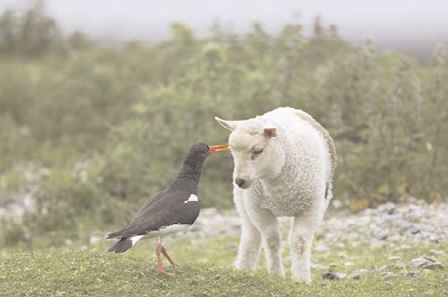
 OYSTERCATCHER
OYSTERCATCHER
(Haematopus ostralegus)
Canon EOS IDs Mark II, 500mm f4 lens + 1.4x converter, beanbag, 1/500th sec @ f5.6, digital ISO 400
Shetland Isles, UK
PENGUINS
Penguins are very photogenic birds and are not shy of people, so one of the usual major problems of bird photography (getting up close) does not apply with them. This means that as a photographer you can concentrate on taking interesting pictures rather than on concealing yourself from the subject. Although penguins make good subjects, because they spend a lot of time standing around action photography is not straightforward – it’s easy to end up with a lot of rather dull pictures of this fascinating group of birds.
Penguins are utterly unlike any other birds, which is why I’ve dedicated a section in this action chapter just to them. One key difference is that they are of course flightless, although I have managed to get some images when they are actually completely off the ground.
In the picture on the left, the Chinstrap Penguin has just returned from the sea, where it has been feeding. Penguins often come ashore at the same spot, and if I can find this I like to position myself nearby and wait for them to appear from the cold Antarctica waters. I find this has several advantages over photographing at the breeding site. One is that the birds are very clean, having just come out of the sea. There is of course water around, which adds another dimension, and they come ashore individually or in small groups, which makes the pictures relatively uncrowded. When they first come ashore they tend to rest on the rocks closest to the sea before heading inland. The shoreline at Ronge Island, where this picture was taken, was covered with boulders, and the Chinstraps found it quite difficult to navigate their way through these rocks as they headed inland. Sometimes to avoid a long detour they would simply jump from rock to rock, and this is the shot I wanted – a flying penguin!
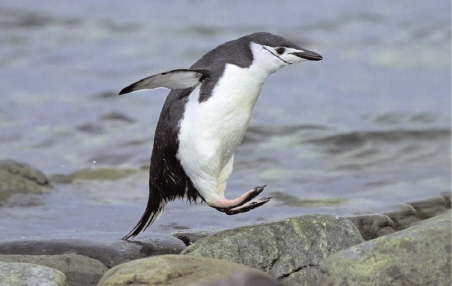
 CHINSTRAP PENGUIN
CHINSTRAP PENGUIN
(Pygoscelis antarctica)
Canon EOS 1D Mark II, 100–400mm lens @ 235mm, hand-held, 1/2,500th sec @ f5.6, digital ISO 400
Antarctica
As I sat quietly in one spot the penguins often came very close to me, and the 100–400mm zoom lens I was using was ideal for framing them, whatever the distance. For this shot I was shooting at just 235mm, which shows how incredibly close the birds were to me. I should point out that you should not approach penguins this closely, but if you settle down in one spot and they come that close to you that is fine – they can break the distance rules, but you shouldn’t.
Although penguins don’t fly in the air, they certainly fly underwater, travelling through it like little torpedoes. Unless you are an underwater photographer this is impossible to photograph, but sometimes a penguin will leap out of the water, retaining forwards momentum before re-entering and continuing on its way. It is thought that this porpoising behaviour may actually save energy, but as it happens so infrequently this is not certain. Regardless of why they do it, this aspect of penguin behaviour does give the surface-based photographer a chance to obtain some spectacular images.
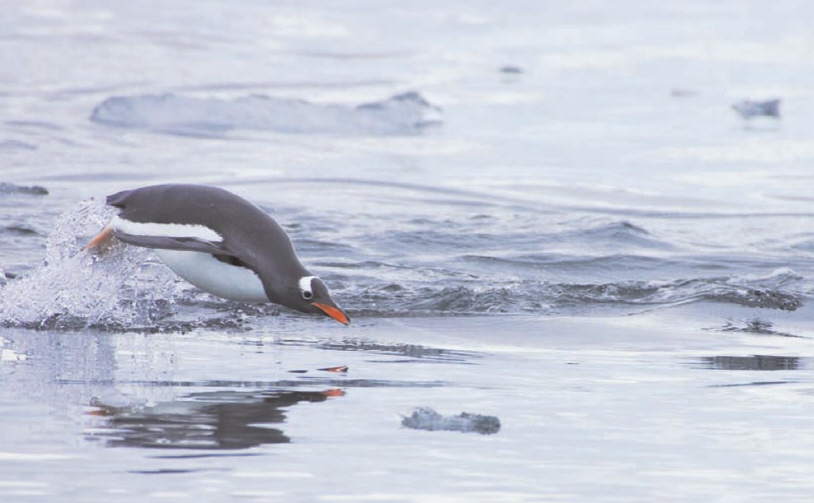
 GENTOO PENGUIN
GENTOO PENGUIN
(Pygoscelis papua)
Canon EOS 1D Mark II, 100–400mm lens @ 400mm, hand-held, 1/1,000th sec @ f8, digital ISO 400
Antarctica
There are serious difficulties in taking pictures like that of the Gentoo Penguin in ‘full flight’ above, since it is almost impossible to predict when the penguin is about to leap out of the water. When I took this shot I was standing on the deck of the ship as we were cruising slowly around the Antarctic peninsula. I noticed a few Gentoo Penguins coming towards us, and some of them were porpoising at regular intervals. I locked on them when they were still too distant for photography, and followed them as they came close. I noticed that the lead penguin would break the surface first, followed by the others, so I waited for the lead penguin to start, then concentrated on the spot behind it. As you can see, I just caught this one at the edge of the frame completely out of the water and with a slight reflection as a bonus. The small pieces of ice floating on the water certainly add atmosphere to the image and highlight the penguin’s cold environment.
The sea is the where the penguins are most at home, and getting ashore is often quite an effort for them as they make the transition from sea to land. This is particularly true of species that build their colonies on rocky coasts, as do the aptly named Rockhopper Penguin and the closely related Macaroni Penguin. These birds bounce around like rubber balls in the pounding surf that often separates them from their nest sites, and watching them crash against the rocks you wonder how they survive. They are very resilient little birds, however, and have sharp claws with which to hold onto the wet rocks as best they can.
This final penguin shot shows a Macaroni Penguin that has just managed to scramble out of the rough sea onto a low rock, although the rock itself has been covered by the previous wave and the water is still draining from it. The bird is using its stumpy wings to try and balance itself before heading off inland. It is not going to make it, though, because that big wave in the background is about to crash onto the rock and knock it back into the sea, where it will have to start all over again. This picture was taken from a zodiac off the rocky coast of Royal Bay on South Georgia, just a few minutes before I had photographed the fighting Northern Giant Petrels shown. It was a very good afternoon’s work indeed.
Although the bird is not spectacularly active, the picture does not lack drama, most of this coming from the splashing water around the bird and the large wave in the background that is clearly heading for it. As usual the positioning of the bird in the frame is key, but this was particularly the case in this instance because I wanted to include as much of that dramatic wave action as possible.
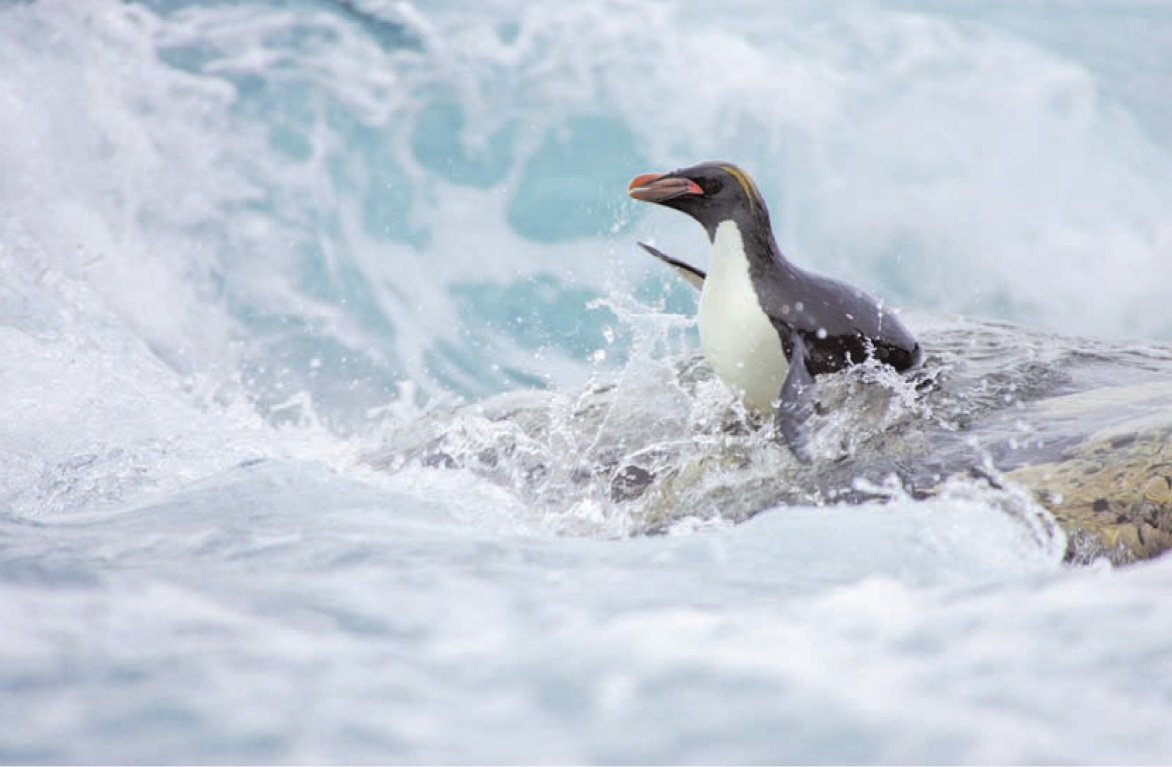
 MACARONI PENGUIN
MACARONI PENGUIN
(Eudyptes chrysolophus)
Canon EOS 1D Mark II, 100–400mm lens @ 400mm, hand-held, 1/400th sec @ f5.6, digital ISO 400
South Georgia